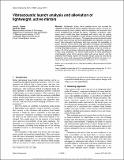Vibroacoustic launch analysis and alleviation of lightweight, active mirrors
Author(s)
Cohan, Lucy E.; Miller, David W.
DownloadCohan-2011-Vibroacoustic launch analysis and alleviation of lightweight, active mirrors.pdf (2.109Mb)
PUBLISHER_POLICY
Publisher Policy
Article is made available in accordance with the publisher's policy and may be subject to US copyright law. Please refer to the publisher's site for terms of use.
Terms of use
Metadata
Show full item recordAbstract
Lightweight, active, silicon carbide mirrors can increase the capability of space-based optical systems. However, launch survival is a serious concern for such systems, with the vibrations and acoustics from launch threatening to damage the optics. Therefore, a dynamic, state-space launch model has been developed with which one can quickly analyze the survival probability of many designs and also directly analyze launch load alleviation techniques. This paper discusses the launch model from which launch stress and survival probability are obtained, as well as launch load alleviation techniques that may increase the probability of launch survival. Three launch load alleviation techniques are presented and analyzed: whole spacecraft isolation, passive shunt circuits using the existing embedded actuators, and active damping using the existing actuators. All of the techniques reduce the launch stress, but at the expense of mass and complexity. The launch model allows for early identification of lightweight, active mirror designs which will survive launch, and the alleviation techniques expand the feasible design space by decreasing the launch stress and increasing the probability of launch survival.
Date issued
2011-01Department
Massachusetts Institute of Technology. Department of Aeronautics and AstronauticsJournal
Optical Engineering
Publisher
Society of Photo-optical Instrumentation Engineers
Citation
Lucy E. Cohan and David W. Miller, "Vibroacoustic launch analysis and alleviation of lightweight, active mirrors", Opt. Eng. 50, 013002 (Jan 20, 2011)© 2011 Society of Photo-Optical Instrumentation Engineers.
Version: Final published version
ISSN
0091-3286